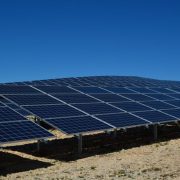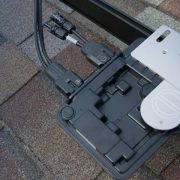Enphase says it is poised for profitable growth. A month after announcing its surprise acquisition of SunPower’s microinverter business, Enphase said the boost to its AC module partnerships will buoy its bottom line. After a scary dip in share prices over the past few years and the risk of […]
Click here to view original web page at www.greentechmedia.com
A month after announcing its surprise acquisition of SunPower’s microinverter business, Enphase said the boost to its AC module partnerships will buoy its bottom line.
After a scary dip in share prices over the past few years and the risk of a Nasdaq delisting* last summer, the acquisition marks an upward trajectory that will continue, according to Enphase Vice President of Marketing and Pricing JD Dillon, during an interview at Intersolar North America.
“The amount of profitable growth in front of the company, we know how to do it, the path is clear,” he said, adding that the share price is “going to go up — higher. Quote me on that. To the moon!”
The acquisition of what could be viewed as a competitor, from a company that looked to be in a tricky financial spot, took many in the industry by surprise.
Historically, Enphase products were not powerful enough to work with SunPower products. Then SunPower’s 2014 acquisition of microinverter company SolarBridge meant that that company’s products became part of SunPower’s vertically integrated line of AC modules. Meanwhile, Enphase went on to work on other AC module partnerships with companies like LG, JinkoSolar and Solaria.
But Greentech Media had heard rumblings that the two companies were working to make a collaboration official. A former Enphase employee who asked to speak anonymously said the growth of SunPower’s market share, as well as new management at Enphase — including some SunPower alums — shifted the company’s position on a partnership.
Enphase’s Dillon said that though conversations had been ongoing, the business case for an acquisition clarified in November. Because the two companies share a vision about the importance of AC modules and both use 25-year warranties, working together made sense, Dillon said.
“A quality and reliability mindset and a belief in the business future of AC modules can overcome any past animosity,” Dillon said. “In the end, business reasons trump all.”
It also didn’t hurt that at the beginning of last year SunPower investor TJ Rodgers dropped $10 million on Enphase. Dillon said the overlap in staff between the two companies is “no mystery.” While he added that it didn’t push the sale, prior working relationships certainly made it more of a natural fit.
As Greentech Media previously reported, SunPower modules will no longer include SolarBridge microinverters. Dillon said the transition from that technology to Enphase products should start in Q4 of this year, after the sale closes, and be complete by Q1 2019. Enphase will develop a completely custom product for integration into SunPower modules.
Enphase won’t ditch SolarBridge’s technology altogether. The company brings a line of over 140 patents and some could be integrated into Enphase’s products, though Dillon said decisions on which to include have not been made.
“It’s more choices for our engineers,” he said. “If you think of patents…as a buffet, our engineers will have more and different things to eat at the buffet when they create a new technology.”
Dillon also said there are no planned changes for Enphase’s existing partnership with SolarWorld, which SunPower acquired in April.
Recently Enphase seems to be clawing its way back to a comfortable position. In its Q1 2018 earnings, the company reported its 2017 net loss decreased from the year prior and that its revenue was up 11 percent from the same quarter in 2017.
Dillon paints the future as rosy. He said he’s not concerned about Trump administration solar tariffs; all he sees is growth.
“There are tremendous opportunities for growth, and we know what they are,” he said, “The stock has to go up, just math tells you that.”
With its next-generation products, the IQ 8 and Ensemble, Enphase will focus more heavily on the off-grid and grid-agnostic market, where Dillon said appetite is growing tremendously. He predicts that more customers investigating those options will bring a “sea change” in the solar market. Enphase plans to get ahead of it.
As for further consolidation in the inverter space, Dillon said he hopes the landscape doesn’t tighten too much, lest it restrict innovation.
“The market is large enough that there needs to be a healthy number of different companies competing in different niches and ways of skinning the cat,” said Dillon.
But, he added, motioning to the trade show floor, “Our industry is an acquiring industry. If you look around, a whole bunch of these folks will probably buy each other.”









